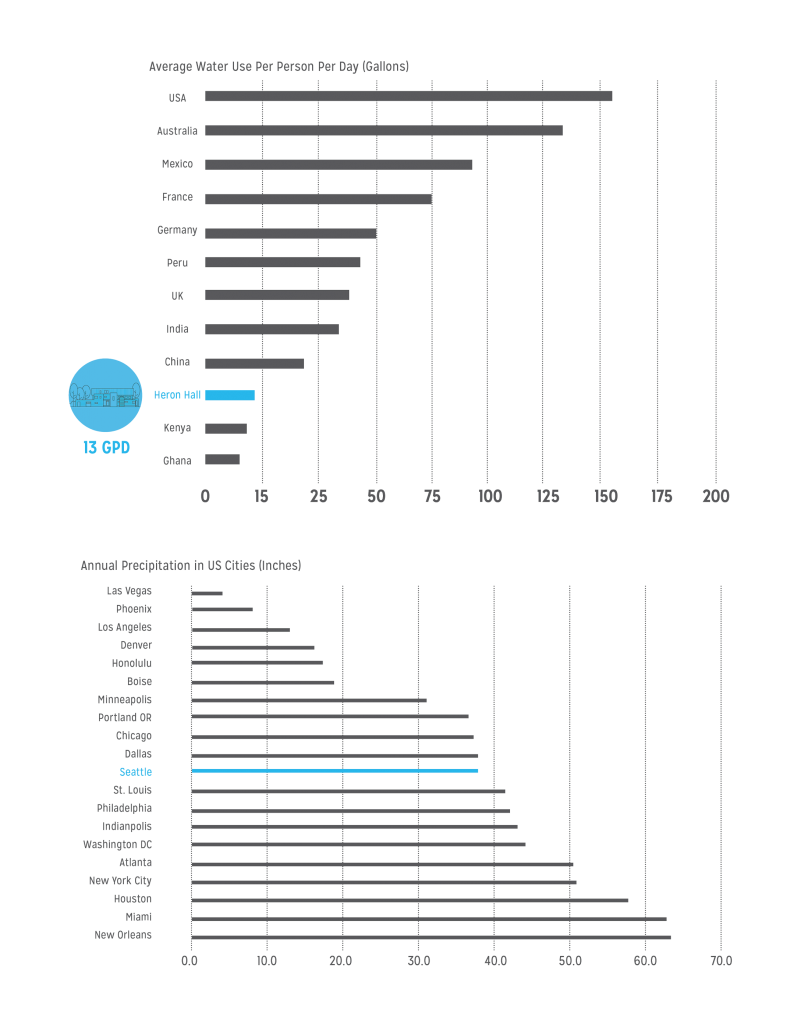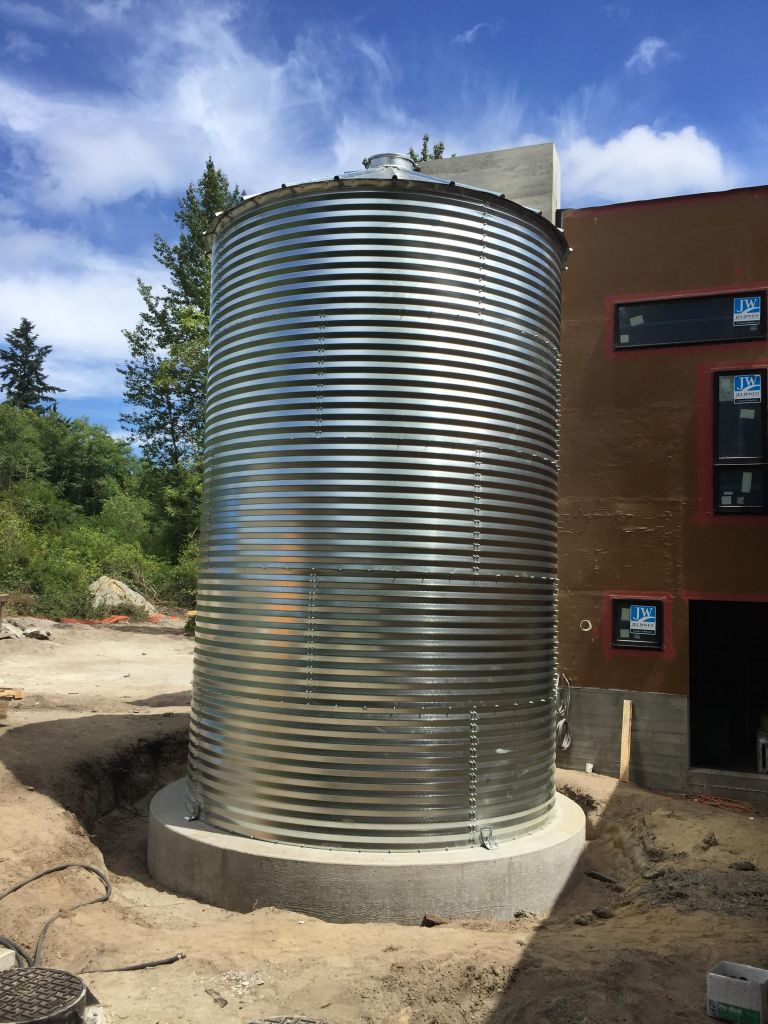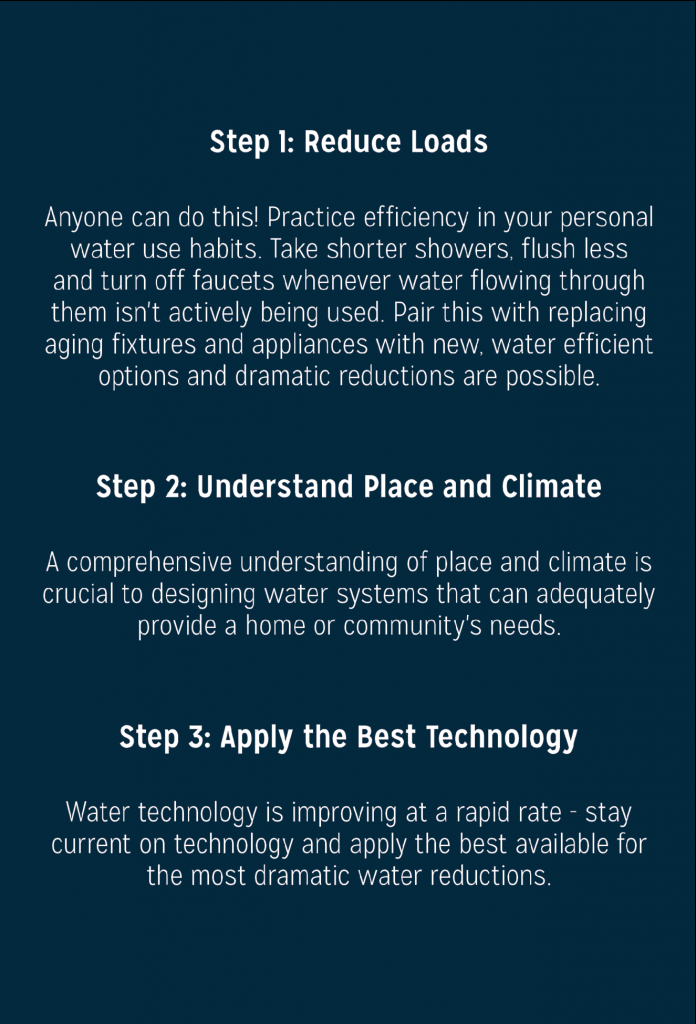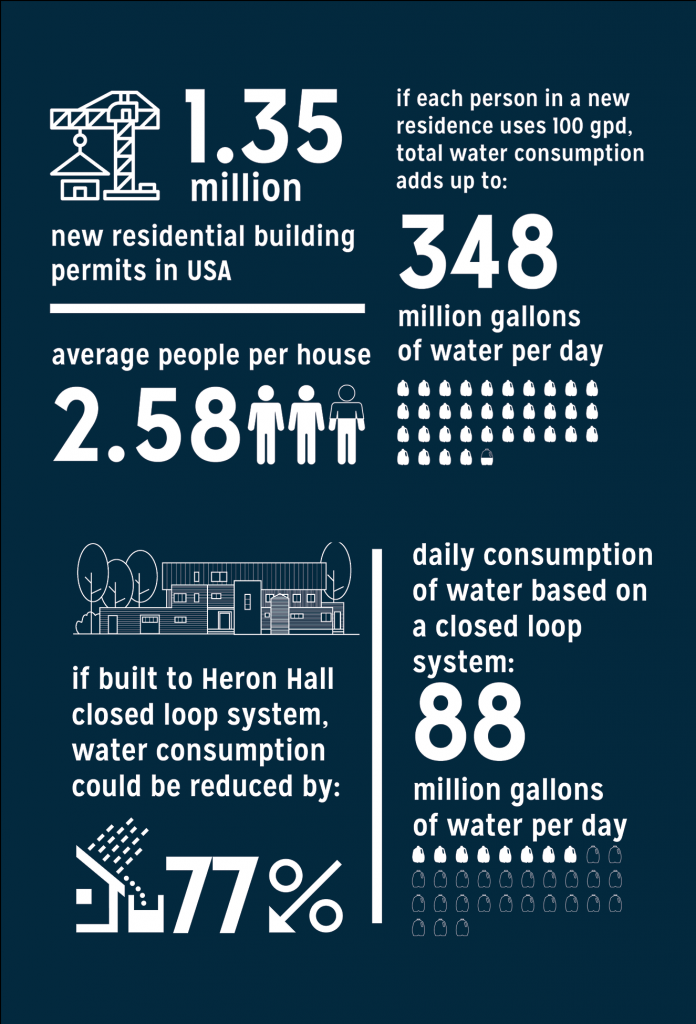A Proven Radical Water Efficiency Paradigm: How a Living Building Home Shows True Water Resilience
Editor’s note: This article is republished with permission from Love + Regeneration, a publication from the regenerative design practice McLennan Design.
The Over Consumption of Water
Since 2015, the world has watched Cape Town, South Africa’s four million residents live with the reality of water scarcity and its experts adjust predictions of when Day Zero – the day when taps are shut off due to exhausted water supply – will arrive. This water crisis has brought attention to the state of water resources and an uncertain future in which water scarcity is a reality the world over. In Cape Town, unchecked population growth combined with years long drought exacerbated by climate change has led to the current crisis, where water is being rationed to 13 gallons per person per day, with the inevitability of system shutdown even so.
The Pacific Institute’s world water conflict database seeks to comprehensively chronicle water conflict going back to ancient times. The database contains 400 entries; thirty-seven of these have occurred since 2010, including skirmishes, terrorist attacks, and armed assaults that have resulted in injury, infrastructural destruction, and death. And the Institute expects to see this increase:

“Our work suggests that the risks of water-related violence and conflict is growing, not diminishing, as population, resources, and economic and environmental pressures on scarce water resources increase. Many of these risks are materializing at the sub-national level rather than as disputes among nations, but even at the national level, there are growing concerns about tensions in Africa and parts of Asia that share international rivers but lack international agreements over how to manage those waters.” [source]
An estimated 780 million people in the world lack access to clean water, resulting in thousands of deaths each day. Additionally, as many as four billion people experience severe water stress for at least one month each year. And Cape Town isn’t the only major city in the world to experience monumental water shortages: according to National Geographic, fourteen of the world’s twenty mega cities are currently experiencing water scarcity or drought conditions.
In the US, where individual water consumption tops world stats at 80 – 150 gallons per person per day, ground water in many places is being depleted at five times the rate of natural replenishment by precipitation. Coastal US cities that rely on groundwater are watching as water levels drop to alarming lows, resulting in salt water encroachment that further threatens what’s left. In Houston, Texas, which receives sixty inches of precipitation annually, groundwater levels have still declined by 400 feet, resulting in both a tenuous water supply and some 10 feet of subsidence, directly contributing to the city’s particular vulnerability to flooding – the repercussions of which have played out to devastating effect in recent years: last year’s Hurricane Harvey costs have been estimated as high as 125 billion dollars and 88 lives were lost.
Many coastal cities have begun looking to the oceans for their water supplies, investing millions in desalination plants. A proposed 100 million gallons per day desalination plant in Texas is estimated to cost $658 million. The proposal suggests several options for disposal of the concentrate stream (the salt and other impurities filtered from the water), including deep well injection, reintroduction to marine environments, or disposal in surface water, all of which have unknown, long-term environmental impacts. Additionally, the energy intensity requirements of this water source dwarf all other sources at more than four times the rate of brackish water and nearly seven times that of groundwater.

In the 20th century, the link between energy and water was largely ignored: systems were developed with the assumption supplies of each would remain robust and inexpensive. But the energy intensity of treating and distributing our dwindling water supplies is increasing: “with water demand growing and many local, low-energy supplies already tapped, water providers are increasingly looking to more remote or alternative water sources that often carry a far greater energy and carbon cost than existing supplies.” [source] Currently, 13% of the US’s energy consumption is spent moving water around, representing 521 MWh/year, which translates to 5% of our annual carbon emissions, and this number is on the rise.
Our current systems are outdated, failing, and environmentally and economically costly. Energy spent solving this crisis is largely directed at fixing these systems, which ultimately amounts to throwing good money after bad. Predictions place the global demand for water at 40% beyond available supply by 2030. And yet, all of these issues around water do not actually have to exist. They all stem from simple overconsumption and an old Victorian era paradigm, unfortunate and unnecessary, especially when models of living exist where people can use radically less water, yet with improved health, economic and ecological outcomes.
LBC – A Radical Approach to Water Systems Design
In 2006, while leading the Cascadia Green Building Council, I launched the Living Building Challenge, a new certification program based on actual measured building performance. Living Buildings’ indicator of success is the data derived from the 12-month performance period, in which systems’ outputs are measured, their functions honed, and the success of the project verified in seven categories, or petals: water, energy, materials, health + happiness, place, beauty and equity.
The intent of the Water Petal is “to meet all water demands within the carrying capacity of the site and mimic natural hydrological conditions, using appropriately-sized and climate-specific water management systems that treat, infiltrate or reuse all resources on-site.” [source] In other words, projects have to be virtually independent of municipal water utilities, and utilize precipitation or groundwater that is fully recharged for 100% of their function. Initially illegal in all jurisdictions across the US, through the advocacy of many, net positive water pathways are now increasingly possible, and projects are demonstrating a completely different relationship to water – one that is in balance with the watershed and climate in which the buildings are located.

Seattle’s Bullitt Center, widely considered the greenest commercial building in the world, has proven the efficacy of the LBC’s vision for water stewardship. The building’s graywater system collects rain that falls on the rooftop PV array, funnels it to a 56,000-gallon cistern in the basement and treats and distributes the water throughout the building. Graywater from sinks and showers is re-collected and circulated through a rooftop constructed wetland before being released to infiltrate at a street level green swale. Thus far, the center does not have the necessary permissions to provide treated rainwater from kitchen faucets in the building, so redefining potable remains a regulatory sticking point, but this is only for a small fraction of the building’s water use. The building is nearly 100% off the water grid.
The Chesapeake Bay Foundation’s Brock Environmental Center serves as another case study for the LBC’s water imperative. The Virginia Beach, VA center is possibly the first commercial building in the United States to receive a permit for drinking treated rainwater (the regulatory obstacle that keeps the Bullitt Center from fully utilizing its graywater system) – an important precedent. With plentiful (45 inches per year) and well distributed rainfall, the system requires just two, 1,650 gallon tanks which can float the center through 23 days of drought. It too utilizes composting toilets and low flow faucets and fixtures. Its native landscape did not require any permanent irrigation measures after an establishment period. The center provides its public a living example of responsible water in tandem with an educational experience focused on the hydrological functioning, overall health, and ongoing conservation of Chesapeake Bay. The pairing of the intense care for place, and in particular the water there, with the demonstrable commitment to living within the means of the ecosystem is a powerful combination not lost on the center’s thousands of annual visitors.


Heron Hall – Taking Residential Living to a New Level
In designing my own home, Heron Hall, I wanted to demonstrate what was possible for a single-family residence and prove that a radical new relationship with water could be both functional and desirable. Many people think that Seattle is an easy place to be net zero for water – and yet the region often has over thirty days of drought or more and a lower rainfall count than most of the eastern and southern cities in the US. My goal was to be completely off the water grid and live on rainwater for all my year-round water needs. The path to net positive water was one of only a few key steps:
Step One – Reducing Loads
The first step towards net zero for water was to dramatically change the amount of water required within the household – something any family can do if there is a willingness to consider different technology choices and behavior patterns. California successfully curbed its water consumption by 25% in response to the 2010-2016 drought just by encouraging individuals to take a more measured, careful approach to habits of consumption, identify and repair inefficient or leaking fixtures, and limit excessive water consumption for non-essentials like private swimming pools and water intensive landscaping. Deeper reductions are possible and often easy.
As a family, we’ve developed habits of personal water use efficiency – we take short showers, we turn off faucets while we’re not actively using the water that flows through them – basic stuff, so we had this going for us automatically.
We selected and installed the most water efficient appliances and fixtures available on the market as a next step to reduce our water demand (dishwasher, washer), and careful design and installation ensured against losing water to leaks.
Because my landscape primarily consists of native or naturalized plantings designed to require very little irrigation beyond their establishment period, I’ve eliminated at Heron Hall what for many homes is a huge water footprint – watering lawns and gardens with potable water. As an added benefit, native plantings elegantly reference place, creating a sense of a home’s belonging in and to its natural surroundings. That said, I did install a separate agriculture cistern from 100% unfiltered rainwater to provide the water for my vegetable gardens and for water during the establishment period of landscape, but it is not potable water and uses only gravity for conveyance.

The majority of personally consumed water in the US, collected or pumped, piped, treated, and available at our fingertips, is used to flush toilets. This makes the toilet our biggest opportunity for designing for radical water reductions. The average person uses (and presumably flushes) a toilet 7 times a day. Each flush is between 1.6 and 3 gallons of potable water, amounting to between 11 and 21 gallons of water per person per day. The final and biggest step in dramatically reducing home water use was in eliminating the flush toilet at Heron Hall. By replacing the standard flush toilet with Phoenix’s foam flush composting toilet system, I now make soil, not waste water. And each flush uses just a cup of water, or .065 gallons per flush. This means I’m using somewhere between 2 to 4% of the water an average person uses throughout the course of a day to flush.
Step Two – Understand Place and Climate for Water Infrastructure
A comprehensive understanding of place and climate was the launching point from which we designed the water systems for Heron Hall and is foundational to designing a water system. In the pacific northwest, rain tends to fall in a concentrated wet season that stretches from October through June, with the summer months of July, August and September generally dry and often without any meaningful precipitation.

Using this information, I worked closely with 2020 Engineers and Rainbank Systems to develop a water plan for my home. Heron Hall’s rainwater catchment system collects the rain that falls on the north and south slopes of its main volume. The water on the north slope is directed to a 15,000-gallon cistern that supplies all the interior water for the house. This cistern was sized based on precipitation and usage predictions to accommodate four months of drought – but as we soon learned after moving in, it was very much oversized.
The water that falls on and is collected from the south slope of the roof is directed to a 9000-gallon agricultural cistern that provides all the necessary water for landscaping and onsite agriculture and makes for a beautiful landscape feature in its own right. By separating the two systems I do not waste energy to treat water that is used for landscape and agriculture. In climates that get less rainfall than Seattle, this water could easily be diverted for use within the house instead of being reserved for outdoor uses, making net zero possible, even in desert regions of the US.
Understanding how the system needed to accommodate the climate was crucial to building one that worked. In parts of the US where there is more or as much annual rainfall, more evenly distributed throughout the year, tanks and catchment areas would be smaller or water could be used more abundantly for landscape. In dryer parts of the country catchment areas may need to be larger to capture enough water to adequately supply a home. My home has several green roof areas not used for rainwater collection, but in a dry climate the entire roof could be used.
Step Three – Apply Best Available Technology
The final step in radical water reduction at Heron Hall was to apply the best technology to using the rainwater the system captured.
Water from the 15,000-gallon cistern is cycled through a 3-step process – a normal filter that is followed by charcoal and finally UV to deliver completely potable water for all needs within the home. Graywater from sinks and showers is not needed to be reused given the efficiency of the home and abundance of water, so it is integrated back into the soil through a drip irrigation system. Again, more arid locations could opt to clean and re-use this water if needed. The composting system requires minimal intervention and sometime 18-24 months after use will produce great topsoil for the garden.

How Did it Turn Out?
Having completed the twelve-month occupancy period for the systems per the Living Building Challenge, we can confirm that each member of my family is using an average of 13 gallons of water per day, a number comparable to the individual water consumption of a person in Bangladesh or Kenya and an 87% reduction from the average American. This is a massive reduction without any drop in quality of experience. In fact, I’d argue that given that the water is rainwater (softer and free of chlorine, fluoride and all sorts of chemicals) that the quality of experience is far superior than the average American experience – but with a fraction of the environmental and economic impact.
Treated rainwater provides my family with an excess of water. Based on actual usage recorded, our cistern could in fact float us through 8 months of drought, which shows we could have easily had a cistern half the size we installed. Or, as designed, it shows that Heron Hall could easily be water independent even in a desert climate like Arizona. Imagine that – 100% rainwater powered homes in the American Southwest – with significantly reduced taxpayer burden and with an enhanced quality of water.
Here is another interesting fact – 14% of the water consumed daily in the average US home is lost to leaky fixtures and plumbing and even more when conveyance as a whole across a community is taken into account. The amount of water I am personally consuming in total in my home each day is equal to or less than the daily amount the average American is losing to system inefficiencies.
What Does This Mean?
How do we share the world’s water equitably among 7.4 billion inhabitants? We start by eliminating waste and rethinking the 150-year-old Victorian water paradigm we have been locked into. Our community water systems are broken, misguided and so wasteful as to be near criminal in intent. We need to start living within our means ecologically, retiring our debunked stories of the restriction and deprivation of doing so. We need to focus on the possibilities for regeneration and the much improved – not diminished – quality of life as evidenced by increased water quality, restored ecology, lowered costs of ownership and lowered or reprioritized taxes. These outcomes can be achieved by leveraging existing technology and collective will to change.

The system in place in Heron Hall is replicable and scalable. With careful adaptations it works in every climate zone in the United States and Canada. With comprehensive understanding of place and the requisite adjustments to the plan, comparable systems can work even in places like southern California and Arizona. It is possible for humans to live and live well in these places while contributing to a world that is equitable, living within the capacity of place and engaging as part of the nutrient cycle. And we can do it now with available and proven technology and systems.
Neighborhood scale water catchment and treatment systems are even more affordable and spread the impact at the sweet spot of scale between accountability and economics so that each home doesn’t have to have its own water treatment system. When these principles are applied to whole new communities, we begin to see change at a meaningful level.
When we incentivize ingenuity around water usage and encourage decentralization – either on a house by house, or preferably block by block basis – we get extremely positive and radical results. Rather than wait for catastrophic failure and the accompanying monumental costs of replacement or overhaul, we need to begin investing in alternatives that successfully utilize the resources of a place without detracting or dumping: closed loop systems that healthfully participate in the ecology of place.

Imagine if Heron Hall wasn’t merely a demonstration home, but the start of a radical new paradigm for water use – what would happen? There are 1.35 million open new residential building permits in the US currently. If these homes were built simply to comply with current building codes and each resident used 100 gallons of water per day, and if they housed the US average of 2.58 people, on a daily basis they would collectively consume 348.3 million gallons of water. If code standards were increased to require the type of closed loop system featured at Heron Hall, and each resident used just 13 gallons of water per day, that number would reduce by 87% to 45 million gallons of water a day, the entirety of which could be rainwater utilized within a closed loop system. National carbon emissions would be reduced significantly and none of these homes would ever have a water bill again.
It is time to move away from the vast centralized water treatment systems bankrupting our communities and shrinking our aquifers and time to begin living in harmony with place and watershed by adopting this new paradigm. Reductions in municipal expenses can be used to phase out our ailing centralized infrastructure, replacing them with more rational and modern approaches to water and waste infrastructure. We could see the health of our ecosystems rebound by way of restored groundwater levels and soil health. By addressing the challenge now, we have the opportunity to create solutions that enhance quality of life and are more equitable, just and sustainable.



